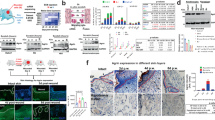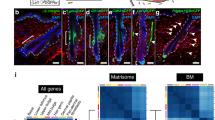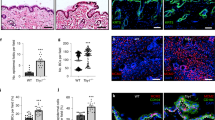Abstract
The ability of skin to act as a barrier is primarily determined by the efficiency of skin cells to maintain and restore its continuity and integrity. In fact, during wound healing keratinocytes migrate collectively to maintain their cohesion despite heterogeneities in the extracellular matrix. Here, we show that monolayers of human keratinocytes migrating along functionalized micropatterned surfaces comprising alternating strips of extracellular matrix (fibronectin) and non-adherent polymer form suspended multicellular bridges over the non-adherent areas. The bridges are held together by intercellular adhesion and are subjected to considerable tension, as indicated by the presence of prominent actin bundles. We also show that a model based on force propagation through an elastic material reproduces the main features of bridge maintenance and tension distribution. Our findings suggest that multicellular bridges maintain tissue integrity during wound healing when cell–substrate interactions are weak and may prove helpful in the design of artificial scaffolds for skin regeneration.
This is a preview of subscription content, access via your institution
Access options
Subscribe to this journal
Receive 12 print issues and online access
$259.00 per year
only $21.58 per issue
Buy this article
- Purchase on Springer Link
- Instant access to full article PDF
Prices may be subject to local taxes which are calculated during checkout





Similar content being viewed by others
References
Diegelmann, R. F. & Evans, M. C. Wound healing: An overview of acute, fibrotic and delayed healing. Front. Biosci. 9, 283–289 (2004).
Martin, P. & Lewis, J. Actin cables and epidermal movement in embryonic wound healing. Nature 360, 179–183 (1992).
Gurtner, G. C., Werner, S., Barrandon, Y. & Longaker, M. T. Wound repair and regeneration. Nature 453, 314–321 (2008).
MacNeil, S. Progress and opportunities for tissue-engineered skin. Nature 445, 874–880 (2007).
Raja Sivamani, K., Garcia, M. S. & Isseroff, R. R. Wound re-epithelialization: Modulating keratinocyte migration in wound healing. Front. Biosci. 12, 2849–2868 (2007).
Greaves, N. S., Iqbal, S. A., Baguneid, M. & Bayat, A. The role of skin substitutes in the management of chronic cutaneous wounds. Wound Repair Regen. 21, 194–210 (2013).
Nelson, C. M. & Tien, J. Microstructured extracellular matrices in tissue engineering and development. Curr. Opin. Biotechnol. 17, 518–523 (2006).
Friedl, P. et al. Migration of coordinated cell clusters in mesenchymal and epithelial cancer explants in vitro. Cancer Res. 55, 4557–4560 (1995).
Rossier, O. M. et al. Force generated by actomyosin contraction builds bridges between adhesive contacts. EMBO J. 29, 1055–1068 (2010).
Doyle, A. D., Wang, F. W., Matsumoto, K. & Yamada, K. M. One-dimensional topography underlies three-dimensional fibrillar cell migration. J. Cell Biol. 184, 481–490 (2009).
Borghi, N., Lowndes, M., Maruthamuthu, V., Gardel, M. L. & Nelson, W. J. Regulation of cell motile behaviour by crosstalk between cadherin- and integrin-mediated adhesions. Proc. Natl Acad. Sci. USA 107, 13324–13329 (2010).
Rosen, P. & Misfeldt, D. S. Cell density determines epithelial migration in culture. Proc. Natl Acad. Sci. USA 77, 4760–4763 (1980).
Trepat, X. et al. Physical forces during collective cell migration. Nature Phys. 5, 426–430 (2009).
Petitjean, L. et al. Velocity fields in a collectively migrating epithelium. Biophys. J. 98, 1790–1800 (2010).
Vedula, S. R. K. et al. Emerging modes of collective cell migration induced by geometrical constraints. Proc. Natl Acad. Sci. USA 109, 12974–12979 (2012).
Jamora, C. & Fuchs, E. Intercellular adhesion, signalling and the cytoskeleton. Nature Cell Biol. 4, E101–E108 (2002).
Theveneau, E. & Mayor, R. Cadherins in collective cell migration of mesenchymal cells. Curr. Opin. Cell Biol. 24, 677–684 (2012).
Sherer, N. M. & Mothes, W. Cytonemes and tunnelling nanotubules in cell–cell communication and viral pathogenesis. Trends Cell Biol. 18, 414–420 (2008).
Rustom, A., Saffrich, R., Markovic, I., Walther, P. & Gerdes, H. H. Nanotubular highways for intercellular organelle transport. Science 303, 1007–1010 (2004).
Zani, B. G., Indolfi, L. & Edelman, E. R. Tubular bridges for bronchial epithelial cell migration and communication. PLoS ONE 5, e8930 (2010).
Ramirez-Weber, F. A. & Kornberg, T. B. Cytonemes: Cellular processes that project to the principal signalling centre in Drosophila imaginal discs. Cell 97, 599–607 (1999).
Bischofs, I. B., Klein, F., Lehnert, D., Bastmeyer, M. & Schwarz, U. S. Filamentous network mechanics and active contractility determine cell and tissue shape. Biophys. J. 95, 3488–3496 (2008).
Thery, M. et al. The extracellular matrix guides the orientation of the cell division axis. Nature Cell Biol. 7, 947–953 (2005).
Hsu, H. J., Lee, C. F., Locke, A., Vanderzyl, S. Q. & Kaunas, R. Stretch-induced stress fibre remodelling and the activations of JNK and ERK depend on mechanical strain rate, but not FAK. PLoS ONE 5, e12470 (2010).
Kaunas, R., Nguyen, P., Usami, S. & Chien, S. Cooperative effects of Rho and mechanical stretch on stress fibre organization. Proc. Natl Acad. Sci. USA 102, 15895–15900 (2005).
Hirata, H., Tatsumi, H. & Sokabe, M. Dynamics of actin filaments during tension-dependent formation of actin bundles. Biochim. Biophys. Acta 1770, 1115–1127 (2007).
Anon, E. et al. Cell crawling mediates collective cell migration to close undamaged epithelial gaps. Proc. Natl Acad. Sci. USA 109, 10891–10896 (2012).
Millan, J. et al. Adherens junctions connect stress fibres between adjacent endothelial cells. BMC Biol. 8, 11 (2010).
Taguchi, K., Ishiuchi, T. & Takeichi, M. Mechanosensitive EPLIN-dependent remodelling of adherens junctions regulates epithelial reshaping. J. Cell Biol. 194, 643–656 (2011).
Yonemura, S., Wada, Y., Watanabe, T., Nagafuchi, A. & Shibata, M. α-Catenin as a tension transducer that induces adherens junction development. Nature Cell Biol. 12, 533–542 (2010).
Benjamin, J. M. et al. AlphaE-catenin regulates actin dynamics independently of cadherin-mediated cell–cell adhesion. J. Cell Biol. 189, 339–352 (2010).
Joanny, J. F. & de Gennes, P. G. A model for contact-angle hysteresis. J. Chem. Phys. 81, 552–562 (1984).
Landau, L. D. & Lifshitz, E. M. Theory of Elasticity Vol. 7, Ch. 13 (Pergamon, 1959).
Kobiela, T. et al. The influence of surfactants and hydrolyzed proteins on keratinocytes viability and elasticity. Skin Res. Technol. 19, e200–e208 (2013).
Fung, C. K. et al. Quantitative analysis of human keratinocyte cell elasticity using atomic force microscopy (AFM). IEEE Trans. Nanobiosci. 10, 9–15 (2011).
Lulevich, V., Yang, H. Y., Isseroff, R. R. & Liu, G. Y. Single cell mechanics of keratinocyte cells. Ultramicroscopy 110, 1435–1442 (2010).
Dembo, M. & Wang, Y. L. Stresses at the cell-to-substrate interface during locomotion of fibroblasts. Biophys. J. 76, 2307–2316 (1999).
Mertz, A. F. et al. Scaling of traction forces with the size of cohesive cell colonies. Phys. Rev. Lett. 108, 198101 (2012).
Reffay, M. et al. Orientation and polarity in collectively migrating cell structures: Statics and dynamics. Biophys. J. 100, 2566–2575 (2011).
Leong, M. C., Vedula, S. R. K., Lim, C. T. & Ladoux, B. Geometrical constraints and physical crowding direct collective migration of fibroblasts. Commun. Integrative Biol. 6, e23197 (2013).
Trichet, L. et al. Evidence of a large-scale mechanosensing mechanism for cellular adaptation to substrate stiffness. Proc. Natl Acad. Sci. USA 109, 6933–6938 (2012).
Weiss, P. & Matoltsy, A. G. Wound healing in chick embryos in vivo and in vitro. Dev. Biol. 1, 302–326 (1959).
Belford, D. A. The mechanism of excisional fetal wound repair in vitro is responsive to growth factors. Endocrinology 138, 3987–3996 (1997).
Kratz, G. Modelling of wound healing processes in human skin using tissue culture. Microsc. Res. Tech. 42, 345–350 (1998).
Gautrot, J. E. et al. Mimicking normal tissue architecture and perturbation in cancer with engineered micro-epidermis. Biomaterials 33, 5221–5229 (2012).
Martin, P., Nobes, C., McCluskey, J. & Lewis, J. Repair of excisional wounds in the embryo. Eye 8 (Pt 2), 155–160 (1994).
Grasso, S., Hernandez, J. A. & Chifflet, S. Roles of wound geometry, wound size, and extracellular matrix in the healing response of bovine corneal endothelial cells in culture. Am. J. Physiol. Cell Physiol. 293, C1327–C1337 (2007).
Wilcox, M., DiAntonio, A. & Leptin, M. The function of PS integrins in Drosophila wing morphogenesis. Development 107, 891–897 (1989).
Bokel, C. & Brown, N. H. Integrins in development: Moving on, responding to, and sticking to the extracellular matrix. Dev. Cell 3, 311–321 (2002).
DiPersio, C. M., Hodivala-Dilke, K. M., Jaenisch, R., Kreidberg, J. A. & Hynes, R. O. α3β1 Integrin is required for normal development of the epidermal basement membrane. J. Cell Biol. 137, 729–742 (1997).
Fink, J. et al. Comparative study and improvement of current cell micro-patterning techniques. Lab Chip 7, 672–680 (2007).
Sveen, J. K. MatPIV—the PIV toolbox for MATLAB. http://folk.uio.no/jks/matpiv/Download/ (2006).
Mertz, A. F. et al. Cadherin-based intercellular adhesions organize epithelial cell-matrix traction forces. Proc. Natl Acad. Sci. USA 110, 842–847 (2013).
Yu, H., Xiong, S., Tay, C. Y., Leong, W. S. & Tan, L. P. A novel and simple microcontact printing technique for tacky, soft substrates and/or complex surfaces in soft tissue engineering. Acta Biomater. 8, 1267–1272 (2012).
Butler, J. P., Tolic-Norrelykke, I. M., Fabry, B. & Fredberg, J. J. Traction fields, moments, and strain energy that cells exert on their surroundings. Am. J. Physiol. Cell Physiol. 282, C595–C605 (2002).
Acknowledgements
The authors thank C. Gay, J-B. Fournier, A. J. Kabla, R-M. Mège, J-M. di Meglio and W. James Nelson for helpful discussions. The authors would also like to thank M. Ashraf and S. Vaishnavi for the microfabrication and C. Xi for the illustrations. Financial support from the Agence Nationale de la Recherche (ANR 2010 BLAN 1515 awarded to B.L.), the Human Frontier Science Program (grant RGP0040/2012) and the Mechanobiology Institute (Team project funding) is gratefully acknowledged. B.L. acknowledges the Institut Universitaire de France (IUF) for its support. The research was conducted in the scope of the International Associated Laboratory Cell Adhesion France Singapore (CAFS). X.T. acknowledges financial support from the Spanish Ministry for Economy and Competitiveness (BFU2012-38146), and the European Research Council (Grant Agreement 242993).
Author information
Authors and Affiliations
Contributions
S.R.K.V., B.L. and C.T.L. designed research, S.R.K.V., M.H.N. and Y.T. performed experiments, H.H. contributed new reagents, S.R.K.V., A.B., H.H., X.T. and B.L. analysed data, S.R.K.V. and B.L. wrote the paper, and B.L. and C.T.L. oversaw the project. All authors read the manuscript and commented on it.
Corresponding authors
Ethics declarations
Competing interests
The authors declare no competing financial interests.
Supplementary information
Supplementary Information
Supplementary Information (PDF 1980 kb)
Supplementary Information
Supplementary Movie S2 (MOV 813 kb)
Supplementary Information
Supplementary Movie S3 (MOV 1048 kb)
Supplementary Information
Supplementary Movie S4 (MOV 2500 kb)
Supplementary Information
Supplementary Movie S5 (MOV 451 kb)
Supplementary Information
Supplementary Movie S6 (MOV 2172 kb)
Supplementary Information
Supplementary Movie S7 (MOV 669 kb)
Supplementary Information
Supplementary Movie S8 (MOV 485 kb)
Supplementary Information
Supplementary Movie S9 (MOV 693 kb)
Supplementary Information
Supplementary Movie S10 (MOV 190 kb)
Supplementary Information
Supplementary Movie S11 (MOV 1151 kb)
Supplementary Information
Supplementary Movie S12 (MOV 319 kb)
Supplementary Information
Supplementary Movie S13 (MOV 583 kb)
Supplementary Information
Supplementary Movie S14 (MOV 1006 kb)
Supplementary Information
Supplementary Movie S15 (MOV 456 kb)
Supplementary Information
Supplementary Movie S16 (MOV 207 kb)
Rights and permissions
About this article
Cite this article
Vedula, S., Hirata, H., Nai, M. et al. Epithelial bridges maintain tissue integrity during collective cell migration. Nature Mater 13, 87–96 (2014). https://doi.org/10.1038/nmat3814
Received:
Accepted:
Published:
Issue Date:
DOI: https://doi.org/10.1038/nmat3814
This article is cited by
-
Emergent collective organization of bone cells in complex curvature fields
Nature Communications (2023)
-
Regeneration in calcareous sponge relies on ‘purse-string’ mechanism and the rearrangements of actin cytoskeleton
Cell and Tissue Research (2023)
-
Mechanical transmission enables EMT cancer cells to drive epithelial cancer cell migration to guide tumor spheroid disaggregation
Science China Life Sciences (2022)
-
Weakening of resistance force by cell–ECM interactions regulate cell migration directionality and pattern formation
Communications Biology (2021)
-
Agrin-Matrix Metalloproteinase-12 axis confers a mechanically competent microenvironment in skin wound healing
Nature Communications (2021)



